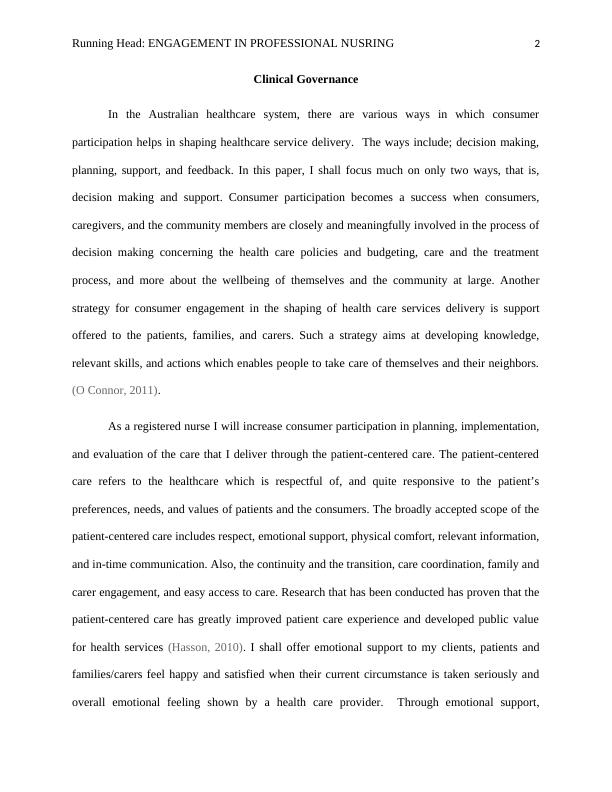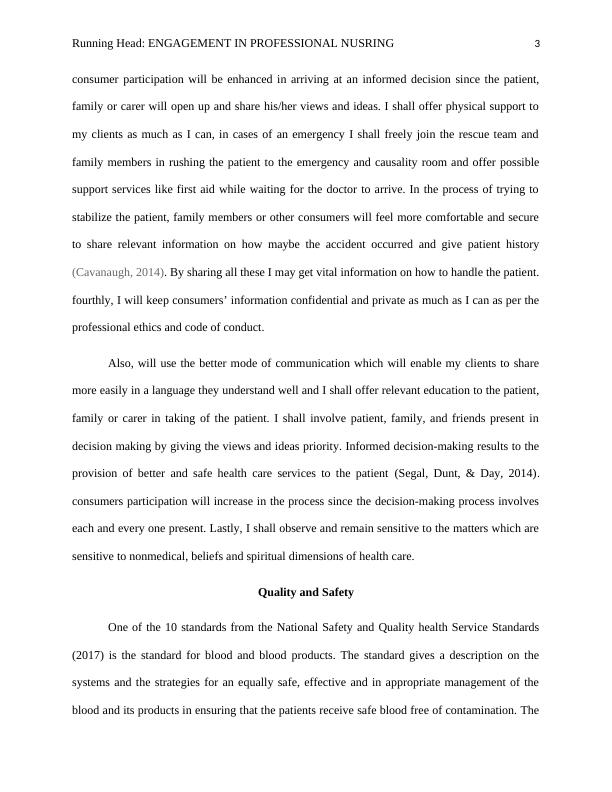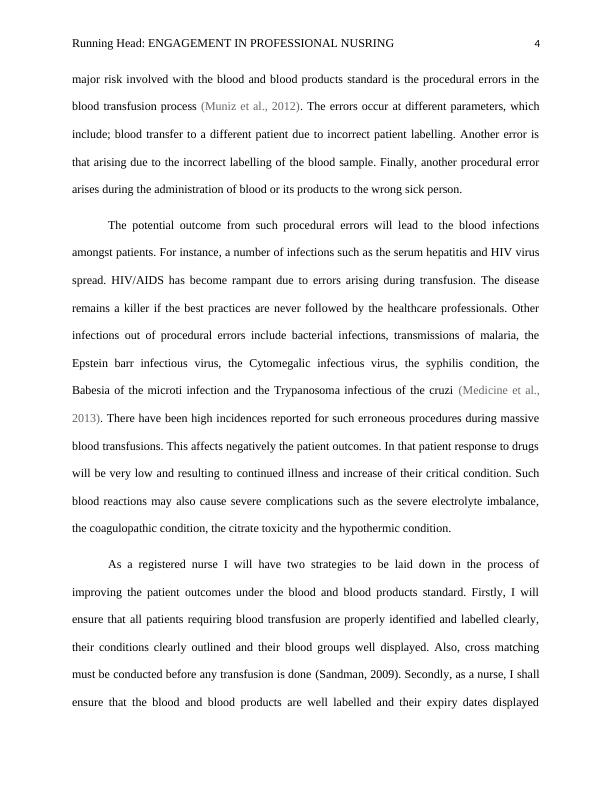Engagement in Professional Nursing
Reflective piece addressing contemporary practice issues relating to each of the five subject modules
11 Pages2897 Words150 Views
Added on 2023-06-04
About This Document
This paper focuses on consumer participation in shaping healthcare service delivery, patient-centered care, quality and safety, leadership and management, and organizational culture in nursing.
Engagement in Professional Nursing
Reflective piece addressing contemporary practice issues relating to each of the five subject modules
Added on 2023-06-04
ShareRelated Documents
Running Head: ENGAGEMENT IN PROFESSIONAL NUSRING 1
Engagement in Professional Nursing
Name
Institution
Date
Engagement in Professional Nursing
Name
Institution
Date

Running Head: ENGAGEMENT IN PROFESSIONAL NUSRING 2
Clinical Governance
In the Australian healthcare system, there are various ways in which consumer
participation helps in shaping healthcare service delivery. The ways include; decision making,
planning, support, and feedback. In this paper, I shall focus much on only two ways, that is,
decision making and support. Consumer participation becomes a success when consumers,
caregivers, and the community members are closely and meaningfully involved in the process of
decision making concerning the health care policies and budgeting, care and the treatment
process, and more about the wellbeing of themselves and the community at large. Another
strategy for consumer engagement in the shaping of health care services delivery is support
offered to the patients, families, and carers. Such a strategy aims at developing knowledge,
relevant skills, and actions which enables people to take care of themselves and their neighbors.
(O Connor, 2011).
As a registered nurse I will increase consumer participation in planning, implementation,
and evaluation of the care that I deliver through the patient-centered care. The patient-centered
care refers to the healthcare which is respectful of, and quite responsive to the patient’s
preferences, needs, and values of patients and the consumers. The broadly accepted scope of the
patient-centered care includes respect, emotional support, physical comfort, relevant information,
and in-time communication. Also, the continuity and the transition, care coordination, family and
carer engagement, and easy access to care. Research that has been conducted has proven that the
patient-centered care has greatly improved patient care experience and developed public value
for health services (Hasson, 2010). I shall offer emotional support to my clients, patients and
families/carers feel happy and satisfied when their current circumstance is taken seriously and
overall emotional feeling shown by a health care provider. Through emotional support,
Clinical Governance
In the Australian healthcare system, there are various ways in which consumer
participation helps in shaping healthcare service delivery. The ways include; decision making,
planning, support, and feedback. In this paper, I shall focus much on only two ways, that is,
decision making and support. Consumer participation becomes a success when consumers,
caregivers, and the community members are closely and meaningfully involved in the process of
decision making concerning the health care policies and budgeting, care and the treatment
process, and more about the wellbeing of themselves and the community at large. Another
strategy for consumer engagement in the shaping of health care services delivery is support
offered to the patients, families, and carers. Such a strategy aims at developing knowledge,
relevant skills, and actions which enables people to take care of themselves and their neighbors.
(O Connor, 2011).
As a registered nurse I will increase consumer participation in planning, implementation,
and evaluation of the care that I deliver through the patient-centered care. The patient-centered
care refers to the healthcare which is respectful of, and quite responsive to the patient’s
preferences, needs, and values of patients and the consumers. The broadly accepted scope of the
patient-centered care includes respect, emotional support, physical comfort, relevant information,
and in-time communication. Also, the continuity and the transition, care coordination, family and
carer engagement, and easy access to care. Research that has been conducted has proven that the
patient-centered care has greatly improved patient care experience and developed public value
for health services (Hasson, 2010). I shall offer emotional support to my clients, patients and
families/carers feel happy and satisfied when their current circumstance is taken seriously and
overall emotional feeling shown by a health care provider. Through emotional support,

Running Head: ENGAGEMENT IN PROFESSIONAL NUSRING 3
consumer participation will be enhanced in arriving at an informed decision since the patient,
family or carer will open up and share his/her views and ideas. I shall offer physical support to
my clients as much as I can, in cases of an emergency I shall freely join the rescue team and
family members in rushing the patient to the emergency and causality room and offer possible
support services like first aid while waiting for the doctor to arrive. In the process of trying to
stabilize the patient, family members or other consumers will feel more comfortable and secure
to share relevant information on how maybe the accident occurred and give patient history
(Cavanaugh, 2014). By sharing all these I may get vital information on how to handle the patient.
fourthly, I will keep consumers’ information confidential and private as much as I can as per the
professional ethics and code of conduct.
Also, will use the better mode of communication which will enable my clients to share
more easily in a language they understand well and I shall offer relevant education to the patient,
family or carer in taking of the patient. I shall involve patient, family, and friends present in
decision making by giving the views and ideas priority. Informed decision-making results to the
provision of better and safe health care services to the patient (Segal, Dunt, & Day, 2014).
consumers participation will increase in the process since the decision-making process involves
each and every one present. Lastly, I shall observe and remain sensitive to the matters which are
sensitive to nonmedical, beliefs and spiritual dimensions of health care.
Quality and Safety
One of the 10 standards from the National Safety and Quality health Service Standards
(2017) is the standard for blood and blood products. The standard gives a description on the
systems and the strategies for an equally safe, effective and in appropriate management of the
blood and its products in ensuring that the patients receive safe blood free of contamination. The
consumer participation will be enhanced in arriving at an informed decision since the patient,
family or carer will open up and share his/her views and ideas. I shall offer physical support to
my clients as much as I can, in cases of an emergency I shall freely join the rescue team and
family members in rushing the patient to the emergency and causality room and offer possible
support services like first aid while waiting for the doctor to arrive. In the process of trying to
stabilize the patient, family members or other consumers will feel more comfortable and secure
to share relevant information on how maybe the accident occurred and give patient history
(Cavanaugh, 2014). By sharing all these I may get vital information on how to handle the patient.
fourthly, I will keep consumers’ information confidential and private as much as I can as per the
professional ethics and code of conduct.
Also, will use the better mode of communication which will enable my clients to share
more easily in a language they understand well and I shall offer relevant education to the patient,
family or carer in taking of the patient. I shall involve patient, family, and friends present in
decision making by giving the views and ideas priority. Informed decision-making results to the
provision of better and safe health care services to the patient (Segal, Dunt, & Day, 2014).
consumers participation will increase in the process since the decision-making process involves
each and every one present. Lastly, I shall observe and remain sensitive to the matters which are
sensitive to nonmedical, beliefs and spiritual dimensions of health care.
Quality and Safety
One of the 10 standards from the National Safety and Quality health Service Standards
(2017) is the standard for blood and blood products. The standard gives a description on the
systems and the strategies for an equally safe, effective and in appropriate management of the
blood and its products in ensuring that the patients receive safe blood free of contamination. The

Running Head: ENGAGEMENT IN PROFESSIONAL NUSRING 4
major risk involved with the blood and blood products standard is the procedural errors in the
blood transfusion process (Muniz et al., 2012). The errors occur at different parameters, which
include; blood transfer to a different patient due to incorrect patient labelling. Another error is
that arising due to the incorrect labelling of the blood sample. Finally, another procedural error
arises during the administration of blood or its products to the wrong sick person.
The potential outcome from such procedural errors will lead to the blood infections
amongst patients. For instance, a number of infections such as the serum hepatitis and HIV virus
spread. HIV/AIDS has become rampant due to errors arising during transfusion. The disease
remains a killer if the best practices are never followed by the healthcare professionals. Other
infections out of procedural errors include bacterial infections, transmissions of malaria, the
Epstein barr infectious virus, the Cytomegalic infectious virus, the syphilis condition, the
Babesia of the microti infection and the Trypanosoma infectious of the cruzi (Medicine et al.,
2013). There have been high incidences reported for such erroneous procedures during massive
blood transfusions. This affects negatively the patient outcomes. In that patient response to drugs
will be very low and resulting to continued illness and increase of their critical condition. Such
blood reactions may also cause severe complications such as the severe electrolyte imbalance,
the coagulopathic condition, the citrate toxicity and the hypothermic condition.
As a registered nurse I will have two strategies to be laid down in the process of
improving the patient outcomes under the blood and blood products standard. Firstly, I will
ensure that all patients requiring blood transfusion are properly identified and labelled clearly,
their conditions clearly outlined and their blood groups well displayed. Also, cross matching
must be conducted before any transfusion is done (Sandman, 2009). Secondly, as a nurse, I shall
ensure that the blood and blood products are well labelled and their expiry dates displayed
major risk involved with the blood and blood products standard is the procedural errors in the
blood transfusion process (Muniz et al., 2012). The errors occur at different parameters, which
include; blood transfer to a different patient due to incorrect patient labelling. Another error is
that arising due to the incorrect labelling of the blood sample. Finally, another procedural error
arises during the administration of blood or its products to the wrong sick person.
The potential outcome from such procedural errors will lead to the blood infections
amongst patients. For instance, a number of infections such as the serum hepatitis and HIV virus
spread. HIV/AIDS has become rampant due to errors arising during transfusion. The disease
remains a killer if the best practices are never followed by the healthcare professionals. Other
infections out of procedural errors include bacterial infections, transmissions of malaria, the
Epstein barr infectious virus, the Cytomegalic infectious virus, the syphilis condition, the
Babesia of the microti infection and the Trypanosoma infectious of the cruzi (Medicine et al.,
2013). There have been high incidences reported for such erroneous procedures during massive
blood transfusions. This affects negatively the patient outcomes. In that patient response to drugs
will be very low and resulting to continued illness and increase of their critical condition. Such
blood reactions may also cause severe complications such as the severe electrolyte imbalance,
the coagulopathic condition, the citrate toxicity and the hypothermic condition.
As a registered nurse I will have two strategies to be laid down in the process of
improving the patient outcomes under the blood and blood products standard. Firstly, I will
ensure that all patients requiring blood transfusion are properly identified and labelled clearly,
their conditions clearly outlined and their blood groups well displayed. Also, cross matching
must be conducted before any transfusion is done (Sandman, 2009). Secondly, as a nurse, I shall
ensure that the blood and blood products are well labelled and their expiry dates displayed

End of preview
Want to access all the pages? Upload your documents or become a member.
Related Documents
4 Principles of Person Centered Care Approach in Healthcarelg...
|1
|972
|438
NSG3EPN - Engagement in Professional Nursinglg...
|16
|3419
|443
Impact of Mental Illness on Clients, Families, and Caregiverslg...
|5
|1149
|262
Improving Communication Skills in End of Life Carelg...
|16
|5091
|473
Dimensions and Model of Healthcarelg...
|9
|2058
|207
Dimensions and Model of Healthcare PDFlg...
|9
|2058
|85
